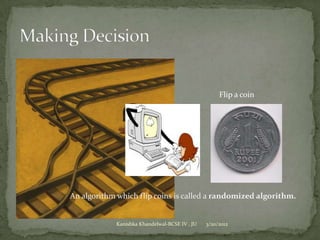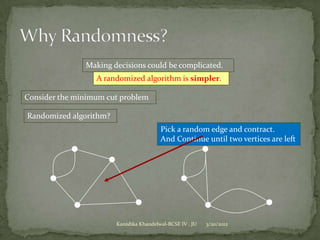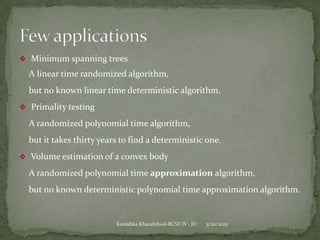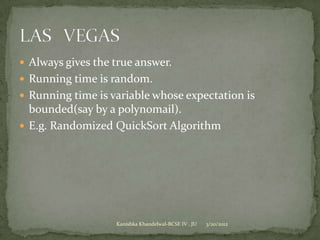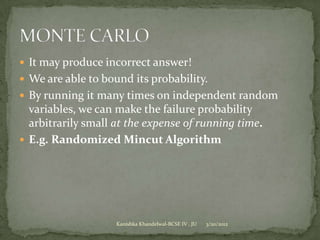Randomized Algorithm
- 1. An Introduction Kanishka Khandelwal-BCSE IV , JU 3/20/2012
- 2. Flip a coin An algorithm which flip coins is called a randomized algorithm. Kanishka Khandelwal-BCSE IV , JU 3/20/2012
- 3. Making decisions could be complicated. A randomized algorithm is simpler. Consider the minimum cut problem Randomized algorithm? Pick a random edge and contract. And Continue until two vertices are left Kanishka Khandelwal-BCSE IV , JU 3/20/2012
- 4. Making good decisions could be expensive. A randomized algorithm is faster. Consider a sorting procedure. Picking an element in the middle makes the procedure very efficient, but it is expensive (i.e. linear time) to find such an element. 5 9 13 11 8 6 7 10 5 6 7 8 9 13 11 10 Picking a random element will do. Kanishka Khandelwal-BCSE IV , JU 3/20/2012
- 5. ï Avoid worst-case behavior: randomness can (probabilistically) guarantee average case behavior ï Efficient approximate solutions to intractable problems ï In many practical problems,we need to deal with HUGE input,and donât even have time to read it once.But can we still do something useful? Kanishka Khandelwal-BCSE IV , JU 3/20/2012
- 6. Deterministic Input Output Computer Random Bits www.lavarnd.org (doesnât use lava lamps anymore) Kanishka Khandelwal-BCSE IV , JU 3/20/2012
- 7. ï Randomized algorithms make random rather than deterministic decisions. ï The main advantage is that no input can reliably produce worst-case results because the algorithm runs differently each time. ï These algorithms are commonly used in situations where no exact and fast algorithm is known. ï Behavior can vary even on a fixed input. Kanishka Khandelwal-BCSE IV , JU 3/20/2012
- 8. ïķ Minimum spanning trees A linear time randomized algorithm, but no known linear time deterministic algorithm. ïķ Primality testing A randomized polynomial time algorithm, but it takes thirty years to find a deterministic one. ïķ Volume estimation of a convex body A randomized polynomial time approximation algorithm, but no known deterministic polynomial time approximation algorithm. Kanishka Khandelwal-BCSE IV , JU 3/20/2012
- 9. Monte Carlo Las Vegas Kanishka Khandelwal-BCSE IV , JU 3/20/2012
- 10. ï Always gives the true answer. ï Running time is random. ï Running time is variable whose expectation is bounded(say by a polynomail). ï E.g. Randomized QuickSort Algorithm Kanishka Khandelwal-BCSE IV , JU 3/20/2012
- 11. ï It may produce incorrect answer! ï We are able to bound its probability. ï By running it many times on independent random variables, we can make the failure probability arbitrarily small at the expense of running time. ï E.g. Randomized Mincut Algorithm Kanishka Khandelwal-BCSE IV , JU 3/20/2012
- 12. ï Suppose we want to find a number among n given numbers which is larger than or equal to the median. Kanishka Khandelwal-BCSE IV , JU 3/20/2012
- 13. Suppose A1 < âĶ < An. We want Ai, such that i âĨ n/2. Itâs obvious that the best deterministic algorithm needs O(n) time to produce the answer. n may be very large! Suppose n is 100,000,000,000 ! Kanishka Khandelwal-BCSE IV , JU 3/20/2012
- 14. ï Choose 100 of the numbers with equal probability. ï find the maximum among these numbers. ï Return the maximum. Kanishka Khandelwal-BCSE IV , JU 3/20/2012
- 15. ï The running time of the given algorithm is O(1). ï The probability of Failure is 1/(2100). ï Consider that the algorithm may return a wrong answer but the probability is very smaller than the hardware failure or even an earthquake! Kanishka Khandelwal-BCSE IV , JU 3/20/2012
- 16. ï QUICKSORT Kanishka Khandelwal-BCSE IV , JU 3/20/2012
- 17. ï QuickSort is a simple and efficient approach to sorting: ï Select an element m from unsorted array c and divide the array into two subarrays: csmall - elements smaller than m and clarge - elements larger than m. ï Recursively sort the subarrays and combine them together in sorted array csorted Kanishka Khandelwal-BCSE IV , JU 3/20/2012
- 18. 1. QuickSort(c) 2. if c consists of a single element 3. return c 4. m ï c1 5. Determine the set of elements csmall smaller than m 6. Determine the set of elements clarge larger than m 7. QuickSort(csmall) 8. QuickSort(clarge) 9. Combine csmall, m, and clarge into a single array, csorted 10. return csorted Kanishka Khandelwal-BCSE IV , JU 3/20/2012
- 19. ï Runtime is based on our selection of m: -A good selection will split c evenly such that |csmall | = |clarge |, then the runtime is O(n log n). -For a good selection, the recurrence relation is: T(n) = 2T(n/2) + const ·n The time it takes to Time it takes to split the sort two smaller array into 2 parts where arrays of size n/2 const is a positive constant Kanishka Khandelwal-BCSE IV , JU 3/20/2012
- 20. However, a poor selection will split c unevenly and in the worst case, all elements will be greater or less than m so that one subarray is full and the other is empty. In this case, the runtime is O(n2). For a poor selection, the recurrence relation is: T(n) = T(n-1) + const · n The time it takes to sort Time it takes to split the array one array containing n-1 into 2 parts where const is a elements positive constant Kanishka Khandelwal-BCSE IV , JU 3/20/2012
- 21. ï QuickSort seems like an ineffecient MergeSort ï To improve QuickSort, we need to choose m to be a good âsplitter.â ï It can be proven that to achieve O(nlogn) running time, we donât need a perfect split, just reasonably good one. In fact, if both subarrays are at least of size n/4, then running time will be O(n log n). ï This implies that half of the choices of m make good splitters. Kanishka Khandelwal-BCSE IV , JU 3/20/2012
- 22. ï To improve QuickSort, randomly select m. ï Since half of the elements will be good splitters, if we choose m at random we will get a 50% chance that m will be a good choice. ï This approach will make sure that no matter what input is received, the expected running time is small. Kanishka Khandelwal-BCSE IV , JU 3/20/2012
- 23. 1. RandomizedQuickSort(c) 2. if c consists of a single element 3. return c 4. Choose element m uniformly at random from c 5. Determine the set of elements csmall smaller than m 6. Determine the set of elements clarge larger than m 7. RandomizedQuickSort(csmall) 8. RandomizedQuickSort(clarge) 9. Combine csmall, m, and clarge into a single array, csorted 10. return csorted Kanishka Khandelwal-BCSE IV , JU 3/20/2012
- 24. ï Worst case runtime: O(m2) ï Expected runtime: O(m log m). ï Expected runtime is a good measure of the performance of randomized algorithms, often more informative than worst case runtimes. Kanishka Khandelwal-BCSE IV , JU 3/20/2012
- 25. ï Making a random choice is fast. ï An adversary is powerless; randomized algorithms have no worst case inputs. ï Randomized algorithms are often simpler and faster than their deterministic counterparts. Kanishka Khandelwal-BCSE IV , JU 3/20/2012
- 26. ï In the worst case, a randomized algorithm may be very slow. ï There is a finite probability of getting incorrect answer. ï However, the probability of getting a wrong answer can be made arbitrarily small by the repeated employment of randomness. ï Getting true random numbers is almost impossible. Kanishka Khandelwal-BCSE IV , JU 3/20/2012
- 27. Assignments Kanishka Khandelwal-BCSE IV , JU 3/20/2012
- 28. ï Input: a set of 2D points ï Determine the closest pair (and its dist) ï Input points are stored in an array ï Suppose we have a strange storage data structure D : ï When we give a point to D, it stores the point and outputs the closest pair of points stored in D ï Our knowledge: Insertion time depends on whether the closest pair is changed or not. ï If output is the same: 1 clock tick ï If output is not the same: |D| clock ticks Kanishka Khandelwal-BCSE IV , JU 3/20/2012
- 29. ï With random insertion order, show that the expected total number of clock ticks used by D is O(n) Kanishka Khandelwal-BCSE IV , JU 3/20/2012
- 30. Suppose you are given a directed graph with n vertices and m unit-length edges. Consider the problem of estimating the number of vertices within distance d of each vertex. Give a fully polynomial approximation scheme that solves this problem simultaneously for all vertices for any fixed d. Kanishka Khandelwal-BCSE IV , JU 3/20/2012


